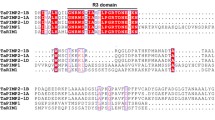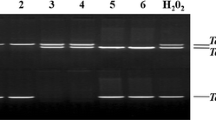Abstract
MYB transcription factors play diverse roles in plant growth, developmental processes and stress responses. A full-length cDNA sequence of a MYB gene, namely TaPIMP1, was isolated from wheat (Triticum aestivum L.). The TaPIMP1 transcript level was significantly up-regulated by inoculation with a fungal pathogen Bipolaris sorokiniana and by drought treatment. TaPIMP1 encodes the MYB protein TaPIMP1 consisting of 323 amino acids. TaPIMP1 contains two MYB DNA binding domains (R2, R3), two putative nuclear localization sites and two putative transcription activation domains. TaPIMP1 is a new member of the R2R3-MYB transcription factor subfamily. Transient expression in onion epidermal cells of GFP fused with TaPIMP1 proved that subcellular localization of TaPIMP1 occurred in the nucleus. The TaPIMP1 gene was transferred into tobacco (Nicotiana tabacum L.) cultivar W38 by Agrobacterium-mediated transformation. After screening through PCR and RT–PCR analyses, transgenic tobacco lines expressing TaPIMP1 were identified and evaluated for pathogen resistance, and drought and salt tolerance. Compared to untransformed tobacco host plants, TaPIMP1 expressing plants displayed significantly enhanced resistance to Ralstonia solanacearum and exhibited improved tolerances to drought and salt stresses. In these transgenic lines, the activities of phenylalanine ammonia-lyase (PAL) and superoxide dismutase (SOD) were significantly increased relative to wild-type tobacco plants. The results suggested that the wheat R2R3-MYB transcription factor plays an important role in modulating responses to biotic and abiotic stresses.








Similar content being viewed by others
References
Abe H, Urao T, Ito T, Seki M, Shinozaki K, Yamaguchi-Shinozakia K (2003) Arabidopsis AtMYC2 (bHLH) and AtMYB2 (MYB) function as transcriptional activators in abscisic acid signaling. Plant Cell 15:63–78
Cedroni ML, Cronn RC, Adams KL, Wilkins TA, Wendel JF (2003) Evolution and expression of MYB genes in diploid and polyploidy cotton. Plant Mol Biol 51:313–332
Chen R, Ni Z, Nie X, Qin YX, Dong GQ, Sun QX (2005) Isolation and characterization of genes encoding Myb transcription factor in wheat (Triticum aestivum L.). Plant Sci 169:1146–1154
Chen YH, Yang XY, He K, Liu MH, Li JG, Gao ZF, Lin ZQ, Zhang YF, Wang XX, Qiu XM, Shen YP, Zhang L, Deng XH, Luo JC, Deng XW, Chen ZL, Gu HY, Qu LJ (2006) The MYB transcription factor superfamily of Arabidopsis: expression analysis and phylogenetic comparison with the rice MYB family. Plant Mol Biol 60:107–124
Chen M, Wang QY, Cheng XG, Xu ZS, Li LC, Ye XG, Xia LQ, Ma YZ (2007) GmDREB2, a soybean DRE-binding transcription factor, conferred drought and high-salt tolerance in transgenic plants. Biochem Biophys Res Commun 353:299–305
Dai X, Xu Y, Ma Q, Xu W, Wang T, Xue Y, Kang C (2007) Overexpression of an R1R2R3 MYB gene, OsMYB3R-2, increases tolerance to freezing, drought, and salt stress in transgenic Arabidopsis. Plant Physiol 143:1739–1751
Dias AP, Braun EL, McMullen MD, Grotewold E (2003) Recently duplicated maize R2R3 myb genes provide evidence for distinct mechanisms of evolutionary divergence after duplication. Plant Physiol 131:610–620
Ding Z, Li S, An X, Liu X, Qin H, Wang D (2009) Transgenic expression of MYB15 confers enhanced sensitivity to abscisic and improved drought tolerance in Arabidopsis thaliana. J Genet Genomics 36:17–29
Dong N, Liu X, Lu Y, Du LP, Xu HJ, Liu HX, Xin ZY, Zhang ZY (2010) Overexpression of TaPIEP1, a pathogen-induced ERF gene of wheat, confers host-enhanced resistance to fungal pathogen Bipolaris sorokiniana. Funct Integr Genomics 10:215–226
Dubos C, Stracke R, Grotewold E, Weisshaar B, Martin C, Lepiniec L (2010) MYB transcription factors in Arabidopsis. Trends Plant Sci 15:573–581
Gay PA, Tuzun S (2000) Temporal and spatial assessment of defense responses in resistant and susceptible cabbage varieties during infection with Xanthomonas campestris pv. campestris. Physiol Mol Plant Pathol 57:201–210
Himi E, Noda K (2005) Red grain colour gene (R) of wheat is a myb-type transcription factor. Euphytica 143:239–242
Horsch RB, Fry JE, Hoffmann NL, Wallroth M, Eichholtr D, Rogers SG, Fraley RT (1985) A simple and general method for transferring genes into plants. Science 227:1229–1231
Ito M, Araki S, Matsunaga S (2001) G2/M-phase-specific transcription during the plant cell cycle is mediated by c-Myb-like transcription factors. Plant Cell 13:1891–1905
Lamb C, Dixon RA (1997) The oxidative burst in plant disease resistance. Ann Rev Plant Physiol Plant Mol Biol 48:251–275
Lee MW, Qi M, Yang Y (2001) A novel jasmonic acid-inducible rice myb gene associates with fungal infection and host cell death. Mol Plant Microb Interact 14:527–535
Livak KJ, Schmittgen TD (2001) Analysis of relative gene expression data using real-time quantitative PCR and the 2−∆∆CT method. Methods 25:402–408
Ma Q, Dai X, Xu Y, Guo J, Liu Y, Chen N, Xiao J, Zhang D, Xu Z, Zhang X, Chong K (2009) Enhanced tolerance to chilling stress in OsMYB3R-2 transgenic rice is mediated by alteration in cell cycle and ectopic expression of stress genes. Plant Physiol 150:244–256
Mengiste T, Chen X, Salmeron J, Dietrich R (2003) The BOTRYTIS SUSCEPTIBLE1 gene encodes an R2R3MYB transcription factor protein that is required for biotic and abiotic stress responses in Arabidopsis. Plant Cell 15:2551–2565
Mittler R, Vanderauwera S, Gollery M, Breusegem FV (2004) Reactive oxygen gene network of plants. Trends Plant Sci 9:490–498
Pellegrini L, Rohfritsch O, Fritig B, Legrand M (1994) Phenylalanine ammonia-lyase in tobacco. Plant Physiol 106:877–886
Rabinowicz PD, Braun EL, Wolfe AD, Bowen B, Grotewold E (1999) Maize R2R3 Myb genes: sequence analysis reveals amplification in the higher plants. Genetics 153:427–444
Raffaele S, Rivas S, Roby D (2006) An essential role for salicylic acid in AtMYB30-mediated control of the hypersensitive cell death program in Arabidopsis. FEBS Lett 580:3498–3504
Raffaele S, Vailleau F, Léger A, Joubès J, Miersch O, Huard C, Blée E, Mongrand S, Domergue F, Roby D (2008) A MYB transcription factor regulates very-long-chain fatty acid biosynthesis for activation of the hypersensitive cell death response in Arabidopsis. Plant Cell 20:752–767
Rahaie M, Xue GP, Naghav MR, Alizadeh H, Schenk PM (2010) A MYB gene from wheat (Triticum aestivum L.) is up-regulated during salt and drought stresses and differentially regulated between salt-tolerant and sensitive genotypes. Plant Cell Rep 29:835–844
Schaffer R, Ramsay N, Samach A, Corden S, Putterill J, Carre IA, Coupland G (1998) The late elongated hypocotyls mutation of Arabidopsis disrupts circadian rhythms and the photoperiodic control of flowering. Cell 93:1219–1229
Schaffer R, Landgraf J, Accerbi M, Simon V, Larson M, Wisman E (2001) Microarray analysis of diurnal and circadian-regulated genes in Arabidopsis. Plant Cell 13:113–123
Seki M, Narusaka M, Ishida J, Nanjo T, Fujita M, Oono Y, Kamiya A, Nakajima M, Enju A, Sakurai T, Satou M, Akiyama K, Taji T, Yamaguchi-Shinozaki K, Carninci P, Kawai J, Hayashizaki Y, Shinozaki K (2002) Monitoring the expression profiles of 7000 Arabidopsis genes under drought, cold and high-salinity stresses using a full-length cDNA microarray. Plant J 31:279–292
Seo PJ, Park CM (2010) Myb96-mediated abscisic acid signals induce pathogen resistance response by promoting salicylic acid biosynthesis in Arabidopsis. New Phytol 186:471–483
Seo PJ, Xiang FN, Qiao M, Park JY, Lee YN, Kim SG, Lee YH, Park WJ, Park CM (2009) The MYB96 transcription factor mediates abscisic acid signaling during drought stress response in Arabidopsis. Plant Physiol 151:275–289
Vailleau F, Daniel X, Tronchet M, Montillet JL, Triantaphylides C, Roby D (2002) A R2R3-MYB gene, AtMYB30, acts as a positive regulator of the hypersensitive cell death program in plants in response to pathogen attack. Proc Natl Acad Sci USA 99:10179–10184
Wu XS, Wang ZH, Chang XP, Jing RL (2010) Genetic dissection of the developmental behaviours of plant height in wheat under diverse water regimes. J Exp Bot 61:2923–2937
Zhang HB, Zhang DB, Chan J, Yang YH, Huang ZJ, Huang DF, Wang XC, Huang RF (2004) Tomato stress-responsive factor TSRF1 interacts with ethylene responsive element GCC box and regulates pathogen resistance to Ralatonia solanacearum. Plant Mol Biol 55:825–834
Zhang ZY, Yao WL, Dong N, Liang HX, Liu HX, Huang RF (2007) A novel ERF transcription activator in wheat and its induction kinetics after pathogen and hormone treatments. J Exp Bot 58:2993–3003
Acknowledgments
The authors are very grateful to Dr. R McIntosh, University of Sydney, Australia, for revising the manuscript and Dr. Daowen Wang for providing the vector h16318 containing GFP gene. This work was funded by the National Natural Science Foundation of China (grant no. 30871523), National Key scientific projects (grant no. 2008ZX08002-001 and grant no. 2009ZX08002-006B), and Core Research Budgets of the Non-profit Governmental Research Institutions (ICS, CAAS) (grant no. 201011).
Author information
Authors and Affiliations
Corresponding author
Additional information
Hongxia Liu and Xianyao Zhou contributed equally to this work.
Electronic supplementary material
Below is the link to the electronic supplementary material.
Suppl. Fig. S1
Amino acid alignment of MYB proteins. Comparison of the amino acid sequences of TaPIMP1 with those of other MYB proteins using Clustal X (1.83) software. Protein names and GenBank accession numbers for the sequences used in this alignment are listed in the text. (DOC 4878 kb)
Suppl. Fig. S2
Salt stress analysis of TaPIMP1 in transgenic tobacco plants. WT and transformed plants were treated with 250 mM NaCl for 40 days; plants were watered at intervals of 10 days prior to assessment. (DOC 4878 kb)
Rights and permissions
About this article
Cite this article
Liu, H., Zhou, X., Dong, N. et al. Expression of a wheat MYB gene in transgenic tobacco enhances resistance to Ralstonia solanacearum, and to drought and salt stresses. Funct Integr Genomics 11, 431–443 (2011). https://doi.org/10.1007/s10142-011-0228-1
Received:
Revised:
Accepted:
Published:
Issue Date:
DOI: https://doi.org/10.1007/s10142-011-0228-1




